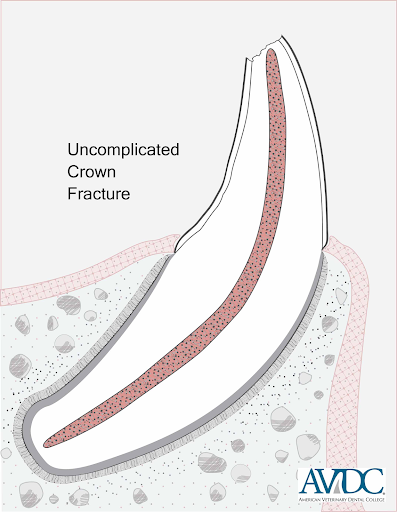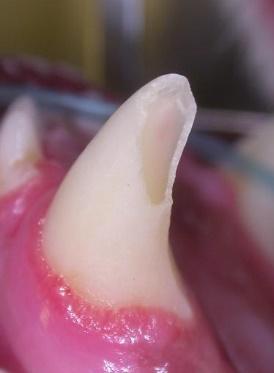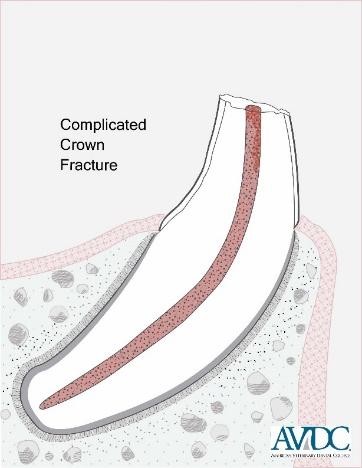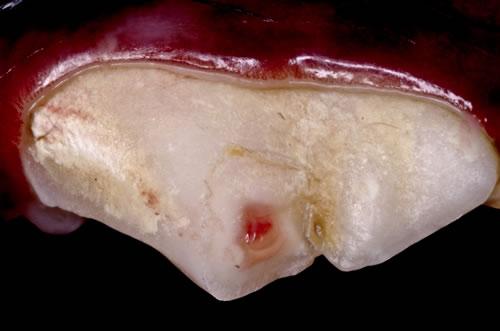
02 Jul Treatment Options for Fractured or Broken Teeth in Dogs
Fractured teeth are common and typically occur when our pets chew on hard objects, like rocks, bones or antlers. Dental fractures can also occur when our pets are victims of trauma, such as being hit by a car. When a dog tooth is broken, there are multiple treatment options to consider. Our veterinary dentists at Animal Dental Care and Oral Surgery will choose a treatment based on whether the pulp cavity of the tooth is exposed, if the tooth is infected or dead, which tooth is fractured and when the fracture occurred. The most important thing to remember with regards to fractured teeth is that it’s not a “wait and see” situation. The sooner a fractured tooth is evaluated by your veterinarian, the better.
The Anatomy of Your Dogs Teeth
As we have discussed in previous posts, the bulk of the tooth is made up of dentin, which is the second hardest tissue of the body. Dentin is permeable and covered by enamel on the crown of the tooth and cementum on the root. Enamel is very hard, yet brittle and impermeable. Cementum is not as hard as enamel and seals dentin of the root.
The pulp canal runs along the center of the tooth and contains blood vessels and nerve fibers. These vessels and nerve fibers enter the tooth at the apex (tip) of the root. The pulp is truly the lifeblood of the tooth.
Two Types of Dog Teeth Fractures
Fractures that crack or chip the enamel exposing dentin, but do not expose the pulp canal, are termed uncomplicated fractures (Figure 1). When the enamel and dentin are broken, exposing the pulp canal, the fracture is a complicated fracture (Figure 2). When complicated crown fractures occur, the tooth may bleed into the mouth since the blood vessels in the pulp were torn and traumatized.
Figure1. The enamel and dentin have been fractured, however, the pulp canal is intact and not exposed. Oral bacteria will be present on the exposed dentin and can potentially migrate through tubules in the dentin to the pulp canal. Uncomplicated fractures may lead to indirect exposure to the pulp canal.


Figure 2. The fracture includes the enamel, dentin and pulp canal. The pulp canal is now open and exposed and oral bacteria have direct access to the pulp. The tooth is inflamed and infected.


Treatment Options for a Broken Dog Tooth
Uncomplicated Crown Fracture
Teeth with an uncomplicated crown fracture can be treated by sealing the fracture site. This treatment must only be performed on teeth that do not have any evidence of infection of the pulp and are periodontally healthy. Evaluating these crown fractures is not possible without dental radiographs and a comprehensive oral exam under anesthesia.
Treating an uncomplicated crown fracture first involves smoothing the fracture site so that it no longer has a roughened surface that will be more plaque retentive. A mild etchant and bonding agent are then applied to seal the exposed dentin. This will inhibit infection and relieve pain associated with the fracture.
With time a tooth with an uncomplicated fracture that has not been treated can become infected. Bacteria on the exposed surface of dentin migrate through small dentin tubules to the pulp canal and potentially cause an irreversible infection of the pulp. Once an irreversible infection of the pulp takes place a smoothing/sealing procedure described above is no longer a viable treatment option. A tooth with an irreversible pulp infection can only be treated appropriately with a surgical extraction or root canal therapy.
Complicated Crown Fractures
Teeth with complicated crown fractures are always considered to be infected and the pulp non-vital (dead). The treatment options for teeth with complicated fractures are root canal therapy or extraction of the tooth.
The exception is if the complicated fracture occurred within the previous 48-72 hours. These fractures can be treated with vital pulp therapy where a pulp dressing cement is placed over the exposure followed by dental composite materials. This treatment allows the tooth to remain alive and continue to develop and is most beneficial in younger dogs.
While root canal treatments can be performed on any tooth in the mouth, they are most often done on strategically important teeth. These teeth include the canines, upper 4th premolars (upper carnassial teeth), lower first molars (lower carnassial teeth) and upper 3rd incisors. Of course all teeth are important, but these strategic teeth have the most important functional properties. If the tooth structure can be saved, we feel it is important to do so. Root canal therapy has a high success rate and is far less traumatic than extracting a tooth. Extraction of these teeth is certainly not a wrong decision, but once extracted the tooth is gone forever.
Your Dog Dentist in Colorado Springs
Broken teeth hurt and although our pets may not show pain, these teeth are a source of significant discomfort. It is not a question of “if” they are in pain, but how could they not be in pain. Fractured teeth are always infected to some degree and can lead to abscess formation in the surrounding tissues. These abscesses can result in facial swelling due to the surrounding bone and soft tissues being involved.
Once again, a broken tooth, whether a complicated or uncomplicated fracture, is never “a wait and see how it goes” situation. Our philosophy at Animal Dental Care and Oral Surgery is for your pet to have a pain free and functional mouth. We will always thoroughly discuss the available options with our clients and decide on the best treatment for them and their pets.
Is your dog suffering from broken or fractured teeth in Castle Rock, Colorado Springs or Loveland, CO?
Contact us today at (719) 536-9949!
Image by Jason Chase from Pixabay (7/2/2019)

